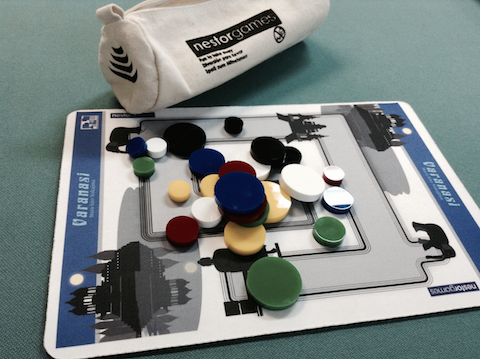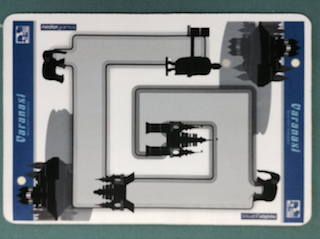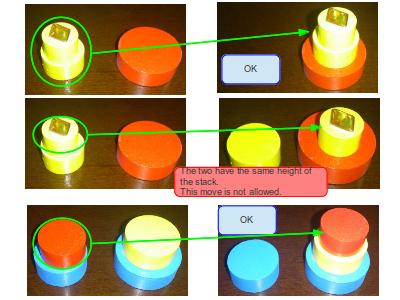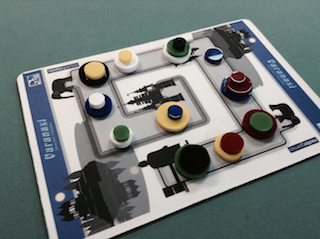Varanasi The World Championship will be held!
History †

Varanasi was invented by Masahiro Nakajima, the Curator of 'The Museum of Abstract Strategy Games', in 2012.
Varanasi, a variant of nim, is an homage to a famous puzzle game Tower of Hanoi. Inherited Tower of Hanoi's puzzle element, the game has been designed in Impartial Game for 2 - 4 players.

This game has been published by Nestor Games from 2014.
BOARD & PIECES †


A decorated board with a line, and 3 or 4 sets of 4 different sizes of disk-shaped pieces are used for 2 or 3 players. (For 3 or 4 players, using 4 to 6 sets of pieces may be appropriate.)
Players place pieces on the line of the board. Smaller pieces can be placed on bigger pieces. The same sized pieces cannot be on top of each other. Pieces that are placed on the board, both by itself, and piled-up, are called stacks.
GAME PLAY †

When all the pieces are placed on the board, the Game starts.
Players in turn take either of the following actions. No pass is allowed:
- Take (a) piece(s)
- Take all the pieces in the same colors placed at the top of all the stacks. Players call out what color they are taking in the turn, then take all the top pieces on stacks in the color that has been declared. (Make sure to take pieces from stacks along the line on the board as you will easily lose track of which stacks you have done with, and which ones you have not.)
- Relocate stacks
- Take one of the stacks and place the pieces all together
on top of the other stacks on the board. Stacks can also be
moved partially: A part of a stack, a piece or multiple
pieces from the top of stacks can be taken and placed on top
of the other stacks. Pieces can only be placed on top of
bigger sized pieces here. Also, pieces can only be relocated
on higher stacks. They cannot be relocated on top of lower
stacks or of the same height.
Any pieces or stacks can be relocated on any higher pieces/stacks on the board.
Players take the above actions in turn. The game is finished when all the pieces on the board are taken.
GOAL †
The player who took that last piece is the winner in the set.
Winner gains the number of the pieces that he/she took from the board in the turn as his/her score in the set. All the other players score 0.
The winner of the game is the player who gained the highest score when all the sets are finished. Players agree on how many sets they are playing before they start the game.
No draw or repetition of moves never happen in each set.
Nestor Version Tournament Rule †
The game finishes when one player reaches the score that has been agreed in advance, instead of being played for certain number of sets.
VARIANTS †
- Doubles
-
4 players are split into two teams. Two teams compete
against each other over a higher total score
Players need to agree if the scores of each set are counted
a) on the winner player
b) or on the team
before starting the game.
- A misère game
- As nim, a misère game (the winner is the one who loses according to the normal game rules) of Varanasi is also fun to play for two players. In the misère game, the winner is the one who does NOT take the last piece.
- Playing Time and Scores
- You can adjust the playing time and range of scores per set by changing the number of pieces. You can also apply different scores to different sizes of pieces.
STRATEGY †
Once you become proficient, you can see who is winning the set when pieces on the board are reduced to a certain number. While it is hard to change the status once it gets clear who is winning in nim, in Varanasi, the status can be changed by relocating pieces / stacks. Even when you know you can not win the set, you should try to distribute the set score in favor of yourself. You need to calculate who should / should not win the set in order that you have a better chance to win when all the sets are finished.
NOTE †

Copyright © Masahiro Nakajima 2012, www.nakajim.net 2012, All rights reserved.
This game is more fun when played with three or more players
![[bigsmile]](/images/face/bigsmile.png) Try
multi-player games with three or four people (Doubles is more
strategic).
Try
multi-player games with three or four people (Doubles is more
strategic).
Varanasi is a variant of nim. Read ahead and find if the player in turn is
winning or not. Starting with limited number of pieces should
be easier. ![[wink]](/images/face/wink.png)
You are probably aware already that the line on the board has got nothing to do with the game rule: The line just helps tracking which stacks you are done with and which are not, among all the stacks you should take pieces from in the turn.